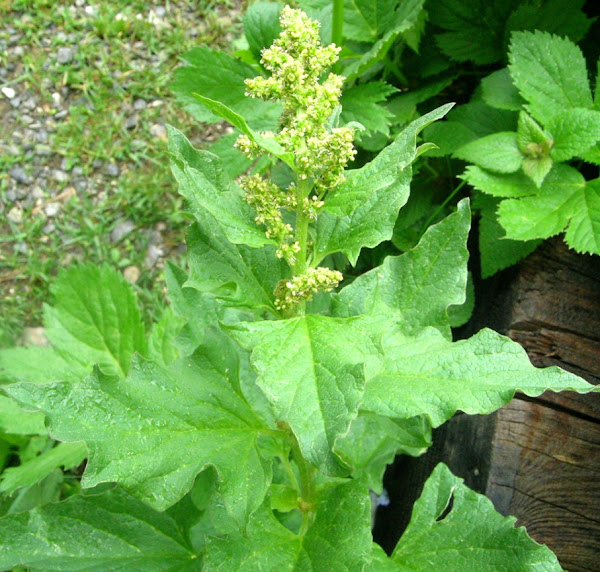Growing good king henry is less popular among the home gardeners and it is more often considered as a weed.
But it is a perennial herb and it’s shoots, flowers and leaves are edible. It is rich in vitamin C and iron and the leaves can be used as a spinach substitute.
Good king henry (Chenopodium bonus-henricus) is a species of goosefoot in the family Chenopodiaceae and is native to much of central and southern Europe.
It has been grown as a vegetable in home garden for hundreds of years. But today, this vegetable is rarely grown and is more often considered as a weed.
The good king henry plants can grow up to 40 to 80 cm tall. The leaves are 5-10 cm broad and long.
Shape of the leaves is triangular to diamond with a pair of broad pointed lobes near the base, with a slightly waxy, succulent texture.
The flowers of the good king henry plants are produced in a tall, nearly leafless spike (10-30 cm long). Each flower of the plant is very small, typically 3-5 mm in diameter.
The flowers are generally of green color with five sepals. And the seeds are tiny, 2-3 mm in diameter and reddish-green colored.
Good king henry is also known by some other names in different parts of the world.
It’s other names include Poor-man’s Asparagus, Perennial Goosefoot, English Mercury, Lincolnshire Spinach, Merkery and Mercury Goosefoot.
However, you can start growing good king henry in your home garden for enjoying this vegetable.
How to Grow Good King Henry
Growing good king henry plants is relatively easy. They are very hardy and generally not fussy about soil type or position.
The plants will provide a green crop throughout the winter season, if the plants have some shelter.
However, here we are trying to describe everything for successfully growing good king henry in your home garden.
Select a Good Location
You have to select a good location for growing good king henry plants in your home garden.
The good king henry plants generally do very well in fertile soil and in sunny location (which is free from perennial weeds).
Preparing the Soil
Good king henry plants can grow well in almost all types of soil. Although the plants will grow best in fertile soil which is rich in organic fertilizers.
So for preparing the soil, till it first and add adequate amount of organic fertilizers into it.
Well-rotted and aged manure or fully decomposed homemade compost will be very good for adding into the soil.

Purchase Seeds
Good king henry plants are grown form seeds. So purchase seeds from any of your nearest garden centers or markets. You can also order the seeds online.
Best Time for Growing Good King Henry
Spring is considered as the best time for growing good king henry plants.
Planting
The good king henry does not respond well to transplantation. So you have to consider sowing the seeds directly into the soil for growing good king henry plants in your home garden.
Try to sow the seeds in rows, because it will make the caring process much easier.
Mark several rows after leveling the soil, and the rows should be at least 1 ft apart. Then sow seeds about 1 cm deep, and 3-4 inch apart.
And when the seedlings appear, thin to about 10 inches apart. Water the bed immediately after sowing seeds.
Caring
The good king henry plants don’t require much care for proper growth.
But you will notice better growth of the plants if you take additional care of the plants.
Common caring tasks for growing good king henry plants are listed below.
Fertilizing: Additional fertilization is not required for growing good king henry plants. The plants will do just fine if you have already prepared the soil by adding lots of organic materials into it.
Watering: Keeping the bed well watered will ensure good growth of the plants. And don’t forget to water the plants, especially during the dry season.
Mulching and Controlling Weeds: Mulching not only helps to retain moisture into the soil, but also helps to prevent most of the weeds from the garden. Use organic materials for mulching such as straw, hay, grass clippings or homemade compost. Also keeping the plants hoed regularly is very important.
Thinning: The good king henry plants don’t do well if they are overcrowded. So, you will need to thin the seedlings when they appear to at least 10 inches apart.
Pests And Diseases
The good king henry plants generally does not suffer from most common pests or diseases. So, you don’t have to worry much about these.
Harvesting
You can’t expect good harvest for the first year. Actually, you will need to allow the plants to grow for a year before harvesting.
You can start harvesting the growing shoots from about April to June to cook in the same way as asparagus.
Leave the shoots to develop after June, and then you can eat the young leaves and flowering stems in salads (or soute the flowers in butter).
These are the common ways for growing good king henry plants in your home garden. Hope you have enjoyed this guide. Good luck & happy gardening 🙂






